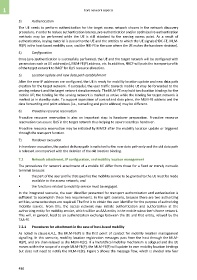Page 496 - 5G Basics - Core Network Aspects
P. 496
1 Core network aspects
3) Authentication
The UE needs to perform authentication for the target access network chosen in the network discovery
procedure. In order to reduce authentication latency, pre-authentication and/or optimized re-authentication
methods may be performed while the UE is still attached to the serving access point. As a result of
authentication, keying material is passed to the UE and the entities to which the UE signals (HDC-FE, MLM-
FE(P) in the host-based mobility case, and the NID-FE in the case where the UE makes the handover decision).
4) Configuration
Once (pre-)authentication is successfully performed, the UE and the target network will be configured with
parameters such as UE address(es), MLM-FE(P) address, etc. In addition, NACF will push the transport profile
of the target network to RACF for QoS resource allocation.
5) Location update and new data path establishment
After the new IP addresses are configured, the UE is ready for mobility location update and new data path
creation for the target network. If successful, the user traffic towards mobile UE may be forwarded to the
serving network and the target network simultaneously. The MLM-FE may hold two location bindings for the
mobile UE; the binding for the serving network is marked as active while the binding for target network is
marked as in standby state. To support separation of control and data plane, the MLM-FE address and the
data forwarding end point address (i.e., tunnelling end point address) may be different.
6) Proactive resource reservation
Proactive resource reservation is also an important step in handover preparation. Proactive resource
reservation can assure QoS in the target network thus helping to assure seamless handover.
Proactive resource reservation may be initiated by MMCF after the mobility location update or triggered
through the transport function.
7) Handover execution
In handover execution, the packet delivery path is switched to the new data path only and the old data path
is released accompanied with the deletion of the old location binding.
7.2 Network attachment, IP configuration, and mobility location management
The procedures for network attachment of a mobile UE differ from those for a fixed or merely nomadic
terminal because:
• the part of the user profile that specifies the mobility service to be granted to the UE must be made
available to the access network; and
• the functions related to mobility service must be engaged.
In the integrated scenario, the user identifier presented for transport authentication and authorization is
sufficient to accomplish these two requirements. In the split scenario, because there are two authorizing
entities, some extra steps are required. The first is to obtain the user identifier for the purpose of authorizing
mobility service. From this, the access network may initiate authentication and authorization at the
authorizing entity for mobility service, which will be an AAA entity in the mobile subscriber's home network.
This will, in general, lead to an authentication exchange between the UE and that entity, relayed by the
TAA-FE.
7.2.1 Procedures for attachment in the case of host-based mobility
As noted in clause 6.4.1, the MLM-FE(P) is the first point of contact for mobility location management
signalling. In this scenario, mobility location registration messages pass from the host through the MLM-
FE(P), and are then relayed to the MLM-FE(C). If a hierarchical mobility mechanism is adopted and the UE
moves within the scope of a single MLM-FE(P), the MLM-FE(P) will update its own mobility location bindings
but does not need to notify the MLM-FE(C). Figure 5 shows the message flow, which is divided into four
486

